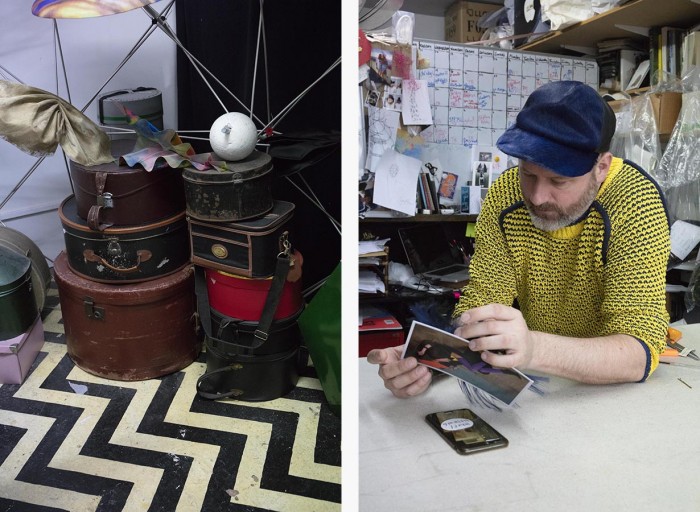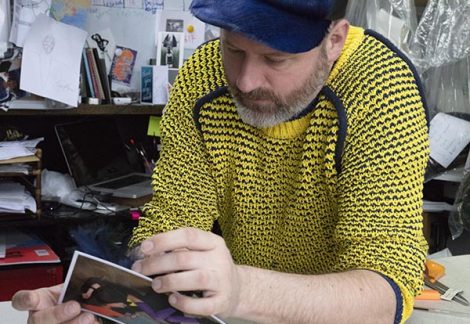Last month, Field Grey founder Janice Turner went to visit Field Grey collaborator Noel Stewart at his studio in Dalston. We have worked with Noel Stewart on two of our major projects: German Gymnasium and our most recent launch, The Principal London. Noel produced a hat for the doormen at each of the projects.
We met Noel in his vibrant studio on Ridley Road. What follows is the conversation between Janice and Noel. Enjoy!
Janice Turner: Working with Christys’ must give you a good understanding of doormen hats – I know they’ve worked with quite a lot of different doorman for hotels?
Noel Stewart: I didn’t know that! They do have a sister company called Compton Webb and they do all the Metropolitan police helmets; they do a lot of uniforms. For me it was really interesting to see how that worked.
JT: How do they make helmets?
NS: The way they make the helmets is wild – it blew my mind. They’re vac formed, sort of. I don’t think I’m allowed to talk about it, it’s considered a military secret! I wanted to do a wild one, like a rainbow one and a green one and some pink ones. And they said – no, we are not allowed to! Those items are signifiers of the law, and they are very heavily protected, in the same way you can’t deface the Queen’s image. It is about protecting and preserving authority.
I was really interesting to see the doorman’s hats in that context. I see hats as fashion, because that’s my background, but to see them in a position of authority and how they identify that was interesting. I did a project for an airline and the designer I was working with was going to drop the hat. At the focus groups the different air hostesses told us how much they love them, saying it ‘identifies us differently and it gives us an authority that we need in the role’. The air hostesses use the hat as a position to help them signify their knowledge, respect and authority.
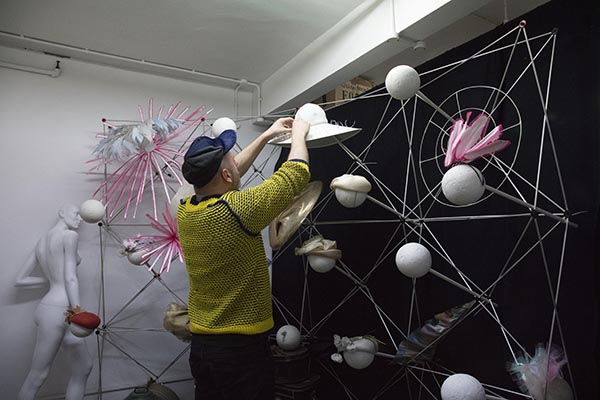
JT: If you were to work on an airline, particularly a flag carrier, who would you choose?
NS: British Airways is amazing and I would love to work for them. I think Virgin could be really fun, or Emirates or something like that which is really high end. You could have fun with Emirates.
JT: What do you think is different about the Principal London project?
NS: I think you’ve been every clever and created something that’s very appropriate for the location. It feels new and exciting, which is a really hard balance. For the hat, we needed something more practical, but at the same time something that has significance. We needed to create that authority so that people can go straight to that person.
JT: You had a tricky task because the [doorman’s] coat is a big thing and everyone fell in love with it and thought: ‘how do we make the hat work now?’
NS: I think as well just that little flash of shine, it’s amazing how the brain works. You have caught that little flash out of the corner of your eye and it draws attention. They say the devil is in the detail.
JT: It makes me think of the military and Horse Guard’s Parade, where you have got that shine coming through…
NS: Yes, but I think also it’s a really unique position for the doorman. I think it’s all those things we’ve discussed about the position of authority, and it’s also welcoming. So, it can’t be too much feeling military and off-putting. It’s got to have a hint of fun about it, a bit of playfulness. The doormen are the first on call; the first welcome to the show.
JT: I don’t think it’s right for a new generation of people that want to stay in the hotel as well. They want to feel relaxed, don’t they?
NS: Completely. They also want to be transported and that’s your trick. You’re here, it’s fine, but at the same time you can totally trust me I’m going to find everything and look after you. And people also are a lot more afraid, these days, and are sort of confused. So now, the authority is even more important in a weird way: that balance of authority and welcoming.
JT: I can’t wait to see your hats in [the hotel’s] corner shop. And I believe they are still working with Selfridges. Are you stocked in Selfridges?
NS: No, and I haven’t been in for years. Hat departments are a funny thing, they come and go depending on the creative director’s whim at a time. I was in there for a little bit and they decided to get rid of the hat department. They brought it back but its been very commercial and more accessible. Hat retailing is a really, really tough thing. Some stores use it to create some excitement.
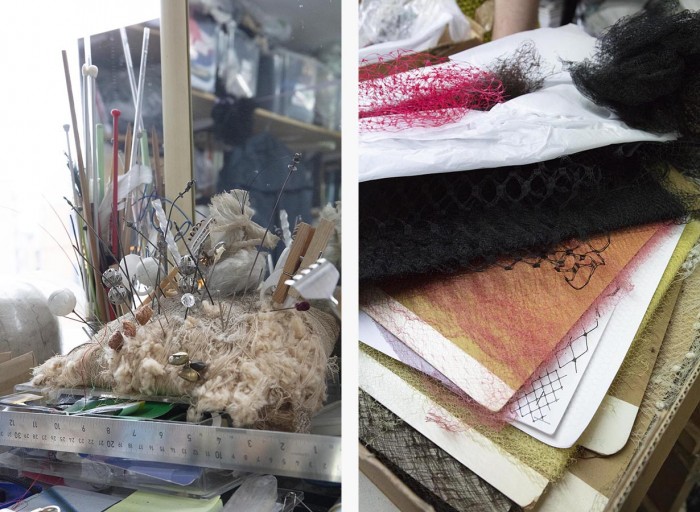
JT: Have you ever been to the Norfolk coast? There’s a big hat shop there. It’s the most incredible place. It’s 8 rooms of hats and they’ve been curated by colour.
NS: I have seen it! I’ve never been in.
JT: You should go and have a look, everyone is in there walking around in fur headbands. It’s quite interesting how, in such a small place, there is this massive hat shop. Anyway, what’s your average day in the life of a milliner? Is there such a thing?
NS: No there bloody well is not, unfortunately! It is very varied. The days that are most exciting tend to be about one specific thing, like I’ve had a fitting meeting with a designer and its gone really well. Or, it’s a shoot day and we’ve shot a collection and for me it’s the end of the collection, when it all come together and it makes sense.
JT: What is the most unusual request you’ve ever had?
NS: There have been some really weird ones! I’ve made a hat for a goose, that was quite strange – for Gifford’s Circus.
JT: I’ve been so many times!
NS: I haven’t been forever, they just called me. I can’t remember how she found out about me, but that was quite strange.
JT: Do you have a big archive of vintage hats? Do you collect hats?
NS: I can’t allow myself to collect hats, because of the space! Obviously I do have some beautiful vintage hats I that I have collected over the years. If I see something really special with a technique or a particular shape I haven’t seen before then I will grab it. But storing hats is a nightmare.
JT: But you keep all of your hats, don’t you?
NS: No, I sell them! If someone wants to buy my hat and it’s in my archive, I will sell it. I don’t want them sitting in boxes, I want them on heads and out there in someone’s life, being loved. Some would prefer to keep their hats, but I can always make it again. Some people get a storage space, God knows where, but I’m not that kind of person.
JT: I used to work at Steinburg and Tolkien and we used to get some amazing things in. We had this hat that I didn’t realise completely folded up for travel. I never thought about women travelling that needed things that folded into suitcases; I was completely amazed.
NS: Yes, either that or you had a hat trunk! The reality is we are living in the world where people are carrying our suitcases and we are not living in a world where people can’t carry loads of luggage, but we need to be able to get around. I did a rolling panama, which is – you fold it in half.
JT: Have you got a favourite hat for personal use?
NS: Yes, it’s just my leather trucker!
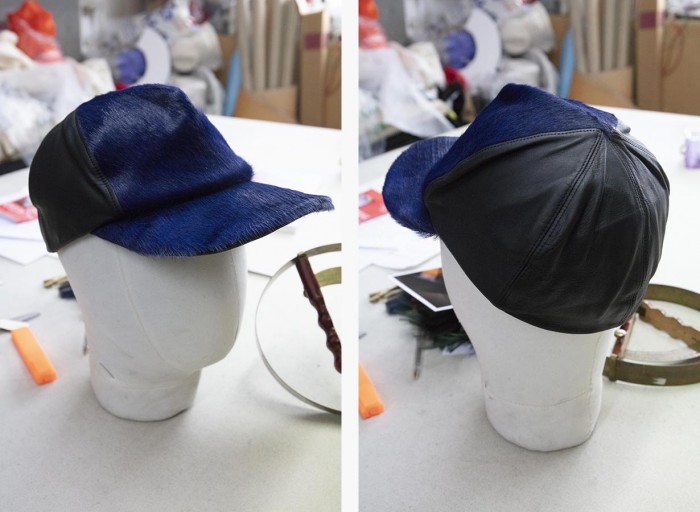
JT: So what’s next for hats?
NS: Our generation is recovering from the previous generation’s attitude to hats. It’s our generation is readdressing the suitability, the appropriateness of the hat. Having been about convention for hundreds of years, it is now about personal choice and about expressing personality and character. I think that’s a wonderful thing. The main thing from my perspective is, people are more confident and comfortable and happy to play around. When I started, everyone was terrified of hats. So many people said to me – hats is a dead industry isn’t it? But I’m doing okay!
JT: If you had a favourite designer from this season that you could work on what would it be?
NS: We’ve just done catwalks for designers; we did Erdem’s veils, sexy sou’westers;
pleather on top and wool underneath, with fake sheepskin ear flaps. I was really happy with them. I really like something soft and luxurious that can also protect you from the rain. It’s so simple.
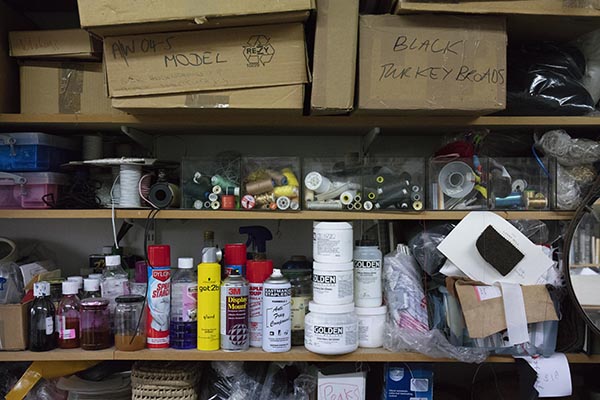
JT: You must have an absolutely hectic run at things, with all of the designer collections all at once? How many people do you end up having in the studio at that time?
NS: It really depends. I’m really lucky that my team can expand and contract as and when I need them.
JT: Do you have any tips of how to choose a hat that suits you? What’s the biggest error people tend to make?
NS: The big error is to be afraid. In a weird way it should feel easy when you’ve given it a bit of time. All you have to do is go in and play and enjoy. Every time you go into a store try on a hat, see what they do to you and how they make you feel. We all know how shoes should feel, we all know how a bag will effect our silhouette; you know what the write shade of lipstick does for you. We don’t know about hats because we don’t choose one every day.
JT: At the V&A’s Balenciaga exhibition they had styles that Balenciaga had made for people to try on. If you do an exhibition about millinery you should do the same: then people will start to really understand hats and how they work!
NS: Yes, and how it creates a different silhouette and how it effects the way you feel! That’s something I’ve always wanted to do. At Christy’s we were launching a new range and we wanted to find a new way to shoot it, so we did an open call with a passport photo pop up. Everyone is so much more comfortable with the camera then they used to be and everyone saw what happened when you wear a hat. Some said ‘I thought it would look hideous’ – that’s the preconceptions about hats. It used to be that a hat department would have someone trained to do it. They would know and they would find things to suit your personality.
JT: We need to get you to do that in somewhere like Selfridges, then!
NS: A hat try-on, that would be cool! The problem with department stores is they don’t want 100 people trying things on. Something tried on four times looks tired. If it’s made by hand: handle it with care, don’t just grab and try on! My grandmother was tought that: it was part of an experience.
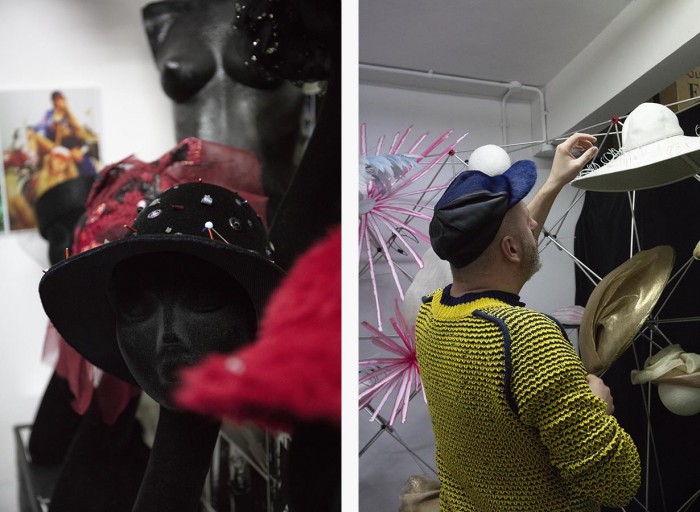
JT: Are you still working as an advisor for the British Fashion Council? Do you enjoy it?
NS: I’ll go in to select the new batch. I had someone support and encourage me when I started there. I’ve taught at the RCA and I really like being able to give back. I could have had some job that isn’t creative or exciting, that lets me meet wonderful people. But I also know its incredibly tough, particularly millinery. There’s no money involved, it’s passion-driven. We’ve been force-fed that we should be making millions of pounds and we should be buying things all the time. I feel, weirdly, quite punk: that I’m choosing to be making things that don’t make huge amounts of money and its just really about crafting things beautifully and making people happy.
JT: Agreed! Do any universities do millinery?
NS: There is Kensington and Chelsea College, which isn’t a university! There is no BA in millinery, which is very sad. The whole world looks to us because we’ve got the best milliners here and in theory the best millinery education. That’s why I feel so lucky I was able to go to the Royal College; they recognised it was necessary to have someone making things by hand that would spend the rest of their life making things by hand.
